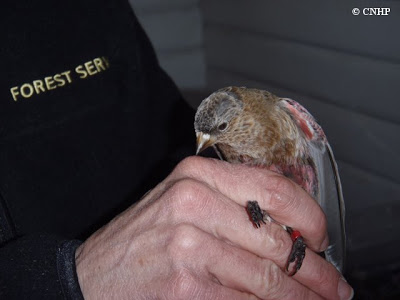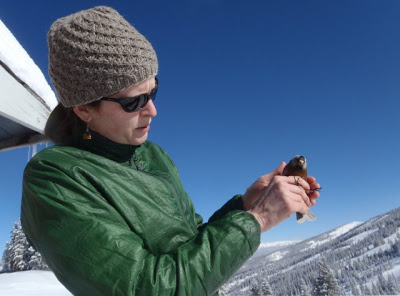Brown-capped Rosy-Finches, found almost exclusively in Colorado, are the focus of a White River National Forest Color Banding Program. With their habitat and breeding sites above timberline, these high elevation birds have been poorly monitored. Due to the limited range of the species, along with recent population declines, the Rocky Mountain Bird Observatory, the Colorado Natural Heritage Program, and the Audubon Society all consider the Brown-capped rosy finch a species of concern.
Last week, we were able to help out at the banding station near Snowmass, Colorado. The lead biologist for the Program, Kim Potter, has been banding Rosy-finches since 2006. The goal of the White River Banding Program is to fill in knowledge gaps about the range of the birds, as well as winter movements.
 |
| Kim Potter, lead biologist for the White River National Forest Color Banding Program, holds a newly banded Brown-Capped Rosy-Finch. The color band on the bird’s left foot is red, representing the banding site in Pitkin County. |
The banding site, located at Snowmass Resort, provides a high elevation banding site where flocks of rosy-finches visit the feeder. The ski patrol staff, along with other Snowmass employees, kindly stock the feeders and allow use of a nearby cabin for the banding Program.
 |
| CNHP staff member, Bernadette Kuhn, holds a Grey-Crowned Rosy Finch at the banding station on Sam’s Knob, Snowmass Ski Resort. |
For more information on Brown-capped Rosy-Finches, check out Jason Beason’s banding reports on the RMBO blog or the species profile on the Audubon Society website.




